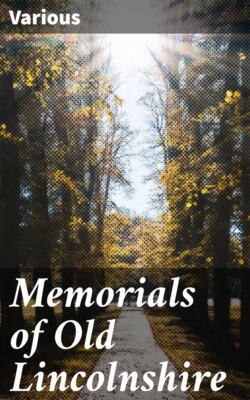Читать книгу Memorials of Old Lincolnshire - Various - Страница 9
На сайте Литреса книга снята с продажи.
The Neolithic Period
ОглавлениеTable of Contents
It is in this period we first find traces of mankind in Lincolnshire. Various burial places and many finds of implements show how widely Neolithic Man spread over and occupied the county.
These implements are described as stone axes, spear-heads, lance-heads, arrow-heads, scrapers, gouges, chisels, pot-boilers, knives, borers, graving tools, hammer stones, whetstones, polishers, sink stones, anvil stones. A list of the places where these “finds” have been recorded is as follows:—
*Alkborough.
Barlings.
*Billinghay.
Branston.
Brigg.
Broughton.
*Burwell.
*Bully Hill.
Caythorpe.
Claxby, near Alford (flint flakes).
Cold Harbour.
*Cold Hanworth.
Crowle.
Coningsby Warren.
Coxey Hills, near Louth.
Doddington.
Donington-on-Bain.
Elkington, South.
Fiskerton.
Fotherby.
Friskney.
Ferriby, South.
Gonerby.
Gonerby, Little.
*Haxey.
Healing (arrow-head).
Horncastle.
Hubbard’s Hills, Louth.
Irby.
*Isle of Axholme.
Keal, West (arrow-heads).
Kelstern.
Kirkstead (axe-head).
Kirton-in-Lindsey.
*Legbourn.
*Lincoln.
*Lynwode.
*Mablethorpe.
Maidenwell.
Manton.
Messingham.
Newport, Lincoln.
Nocton (axe-head).
Ponton, Great.
Potterhanworth.
Reepham.
*Ruckland.
*Salmonby.
Saxilby.
*Scawby.
*Scunthorpe (arrow-heads).
Sleaford.
Spalding (spear-head).
Stewton.
*Stow.
Tathwell.
Tetford (arrow-heads).
Welton, by Lincoln (whetstone).
Wragby.
Woodhall.
*Witham River.
Those marked with an asterisk (*) are to be seen in the County Museum at Lincoln.
Many of these implements are excellent specimens of the art and skill of the Neolithic workers in stone. For the purpose for which they were made, they seem to have served well.
The axe-heads have been (in some cases) made to be used with wood handles formed out of the branches of trees. In the course of ages the handles have perished, but the stone implement remains.
Often people unacquainted with the subject of stone implements ask, “How do these stone implements differ from stone forms of natural shape?” There are several points for students to notice about “Worked Stone Implements.” The points to be noticed with the Old Stone or Paleolithic Implements are as follows:—
1. The Flat Top, where the blow was struck to separate the implement from the flint nodule.
2. The Bulb of Percussion caused by the blow.
3. The Conchoidal Fracture or shell-like flake.
4. The Flaking off at the back.
5. The Dorsal Ridge or Ridges.
6. The Secondary Working, round the edges.
7. The Patina or Skin, the result of exposure to the weather.
In the characteristics of the New Stone Implements, or Neolithic Stones, which are found in Lincolnshire, the points to be noticed are—
1. The Definite Shaping of the Stone.
2. The Worked Edges of the Implement.
3. The Piercing or Socketing of the Stone.
4. The Patination of the Implement.
